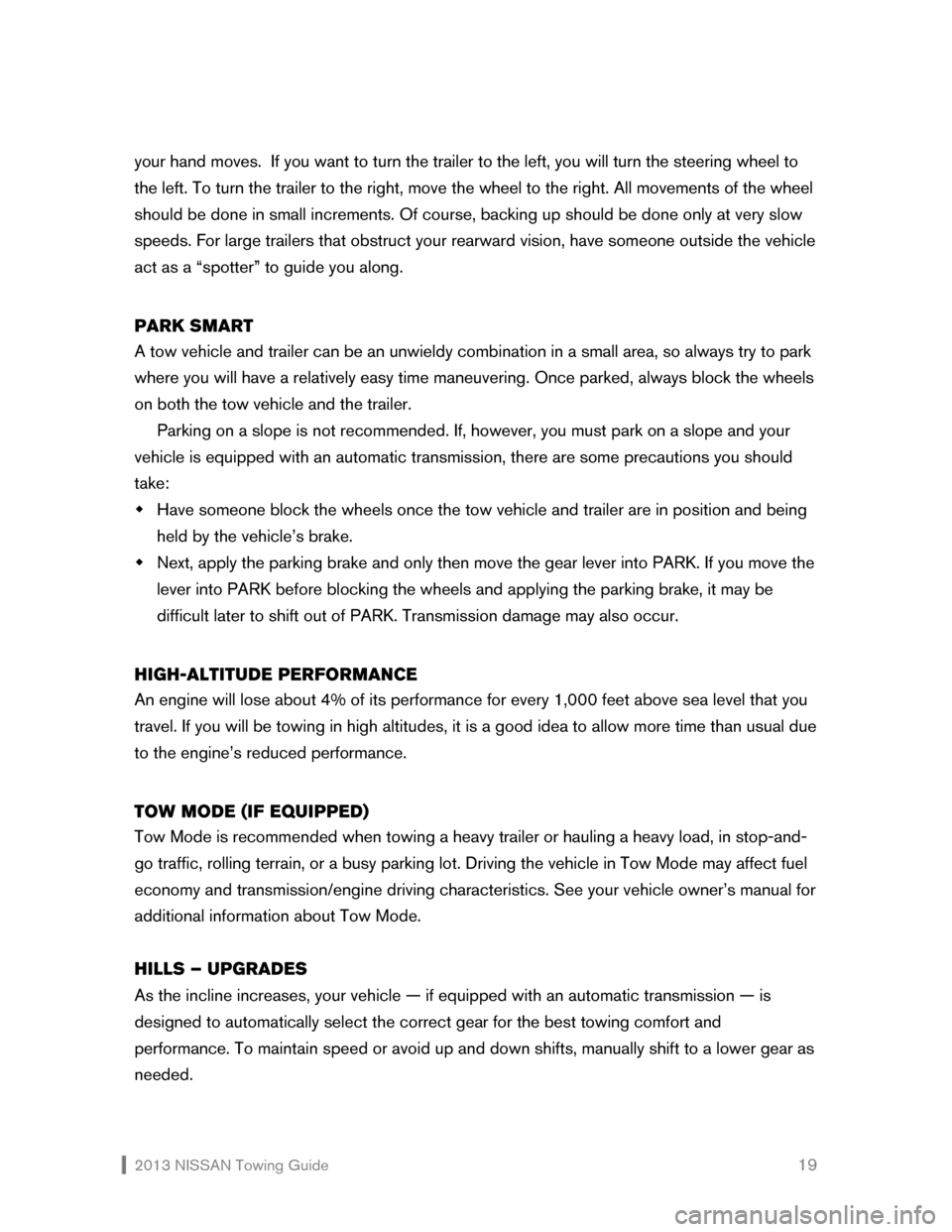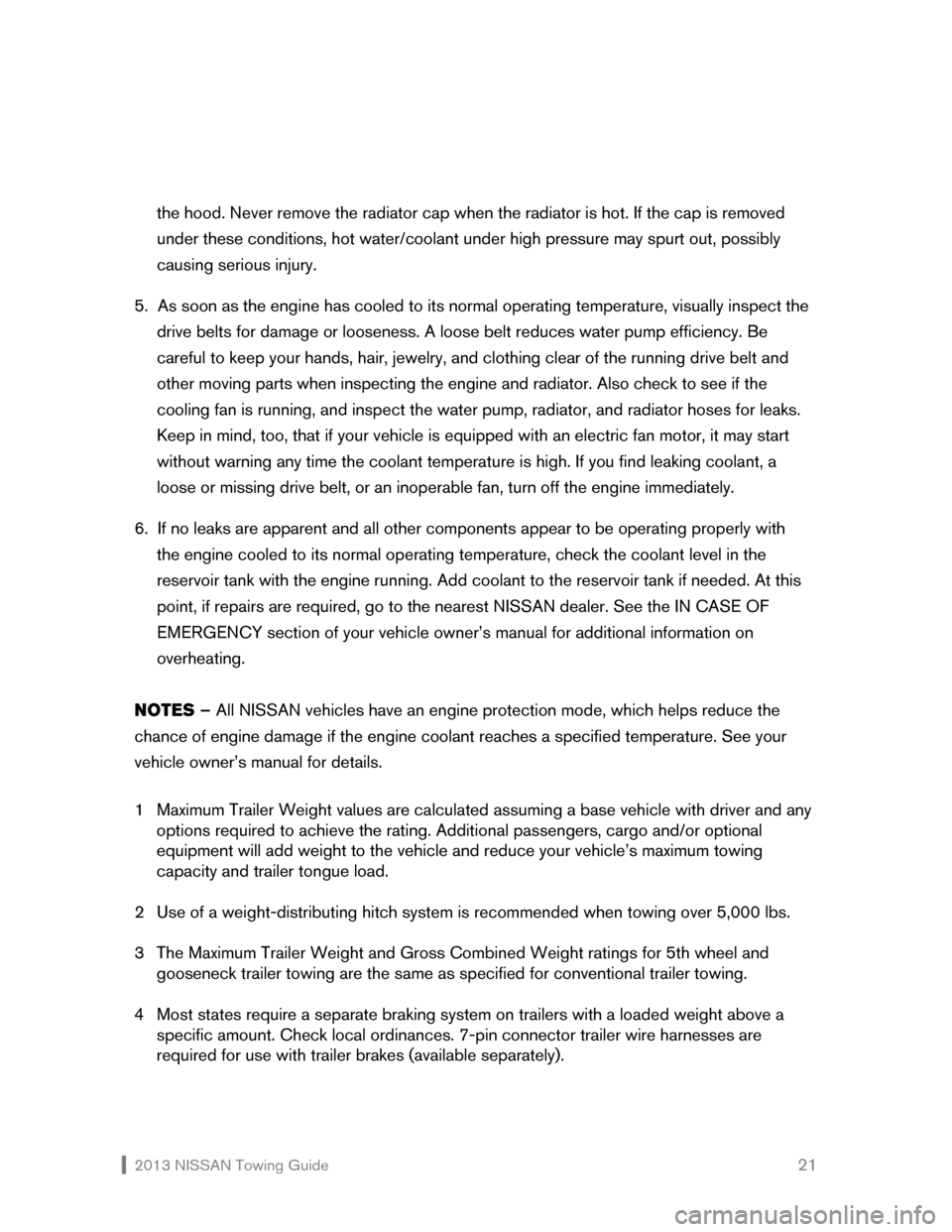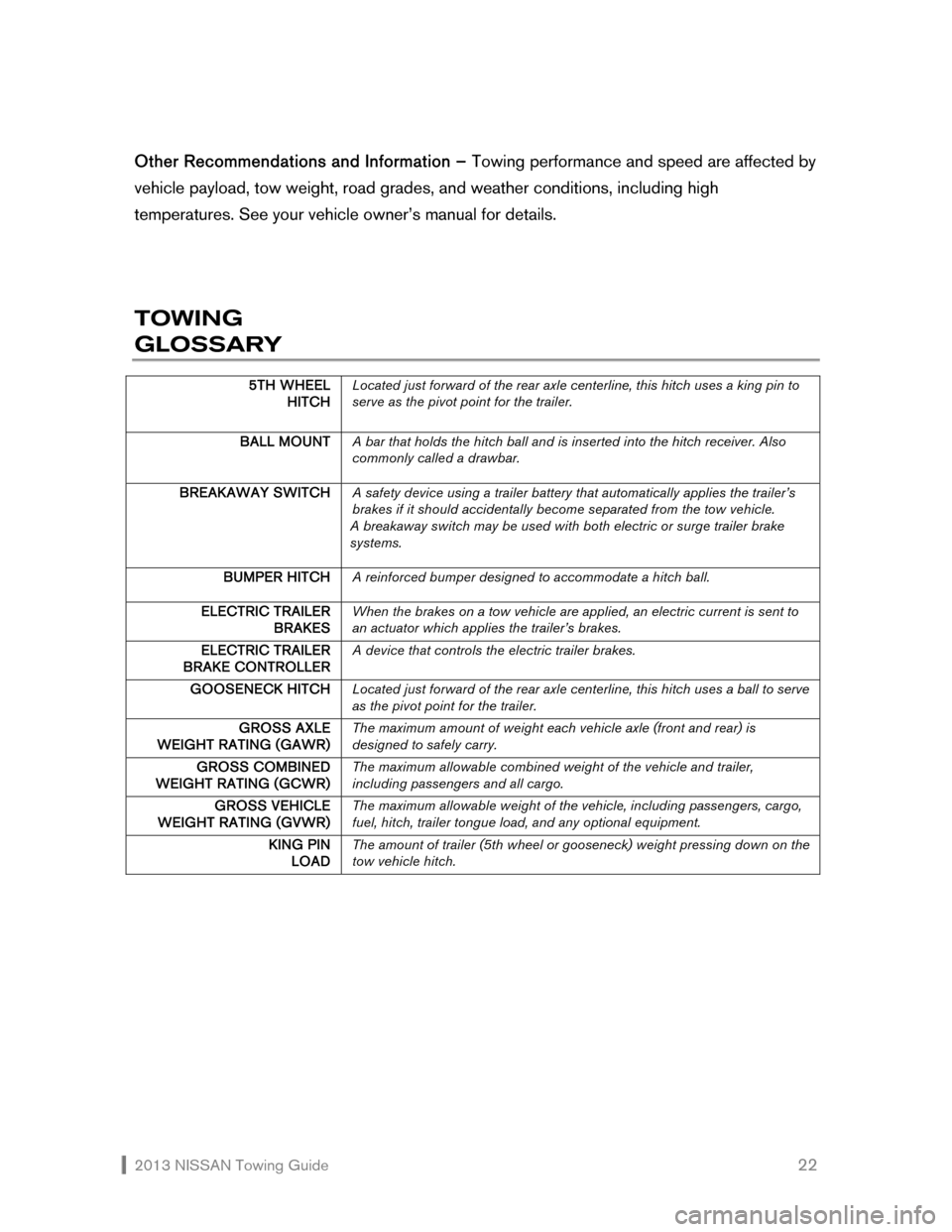wheel NISSAN CUBE 2013 3.G Towing Guide
[x] Cancel search | Manufacturer: NISSAN, Model Year: 2013, Model line: CUBE, Model: NISSAN CUBE 2013 3.GPages: 27, PDF Size: 0.49 MB
Page 20 of 27

2013 NISSAN Towing Guide 19 your hand moves. If you want to turn the trailer to the left, you will turn the steering wheel to
the left. To turn the trailer to the right, move the wheel to the right. All movements of the wheel
should be done in small increments. Of course, backing up should be done only at very slow
speeds. For large trailers that obstruct your rearward vision, have someone outside the vehicle
act as a “spotter” to guide you along.
PARK SMART
A tow vehicle and trailer can be an unwieldy combination in a small area, so always try to park
where you will have a relatively easy time maneuvering. Once parked, always block the wheels
on both the tow vehicle and the trailer.
Parking on a slope is not recommended. If, however, you must park on a slope and your
vehicle is equipped with an automatic transmission, there are some precautions you should
take:
�Š Have someone block the wheels once the tow vehicle and trailer are in position and being
held by the vehicle’s brake.
�Š Next, apply the parking brake and only then move the gear lever into PARK. If you move the
lever into PARK before blocking the wheels and applying the parking brake, it may be
difficult later to shift out of PARK. Transmission damage may also occur.
HIGH-ALTITUDE PERFORMANCE
An engine will lose about 4% of its performance for every 1,000 feet above sea level that you
travel. If you will be towing in high altitudes, it is a good idea to allow more time than usual due
to the engine’s reduced performance.
TOW MODE (IF EQUIPPED)
Tow Mode is recommended when towing a heavy trailer or hauling a heavy load, in stop-and-
go traffic, rolling terrain, or a busy parking lot. Driving the vehicle in Tow Mode may affect fuel
economy and transmission/engine driving characteristics. See your vehicle owner’s manual for
additional information about Tow Mode.
HILLS – UPGRADES
As the incline increases, your vehicle — if equipped with an automatic transmission — is
designed to automatically select the correct gear for the best towing comfort and
performance. To maintain speed or avoid up and down shifts, manually shift to a lower gear as
needed.
Page 22 of 27

2013 NISSAN Towing Guide 21
the hood. Never remove the radiator cap when the radiator is hot. If the cap is removed
under these conditions, hot water/coolant under high pressure may spurt out, possibly
causing serious injury.
5. As soon as the engine has cooled to its normal operating temperature, visually inspect the
drive belts for damage or looseness. A loose belt reduces water pump efficiency. Be
careful to keep your hands, hair, jewelry, and clothing clear of the running drive belt and
other moving parts when inspecting the engine and radiator. Also check to see if the
cooling fan is running, and inspect the water pump, radiator, and radiator hoses for leaks.
Keep in mind, too, that if your vehicle is equipped with an electric fan motor, it may start
without warning any time the coolant temperature is high. If you find leaking coolant, a
loose or missing drive belt, or an inoperable fan, turn off the engine immediately.
6. If no leaks are apparent and all other components appear to be operating properly with
the engine cooled to its normal operating temperature, check the coolant level in the
reservoir tank with the engine running. Add coolant to the reservoir tank if needed. At this
point, if repairs are required, go to the nearest NISSAN dealer. See the IN CASE OF
EMERGENCY section of your vehicle owner’s manual for additional information on
overheating.
NOTES – All NISSAN vehicles have an engine protection mode, which helps reduce the
chance of engine damage if the engine coolant reaches a specified temperature. See your
vehicle owner’s manual for details.
1 Maximum Trailer Weight values are calculated assuming a base vehicle with driver and any
options required to achieve the rating. Additional passengers, cargo and/or optional
equipment will add weight to the vehicle and reduce your vehicle’s maximum towing
capacity and trailer tongue load.
2 Use of a weight-distributing hitch system is recommended when towing over 5,000 lbs.
3 The Maximum Trailer Weight and Gross Combined Weight ratings for 5th wheel and
gooseneck trailer towing are the same as specified for conventional trailer towing.
4 Most states require a separate braking system on trailers with a loaded weight above a
specific amount. Check local ordinances. 7-pin connector trailer wire harnesses are
required for use with trailer brakes (available separately).
Page 23 of 27

2013 NISSAN Towing Guide 22 Other Recommendations and Information – Towing performance and speed are affected by
vehicle payload, tow weight, road grades, and weather conditions, including high
temperatures. See your vehicle owner’s manual for details.
TOWING
GLOSSARY
5TH WHEEL
HITCH Located just forward of the rear axle centerline, this hitch uses a king pin to
serve as the pivot point for the trailer.
BALL MOUNT A bar that holds the hitch ball and is inserted into the hitch receiver. Also
commonly called a drawbar.
BREAKAWAY SWITCH A safety device using a trailer battery that automatically applies the trailer’s
brakes if it should accidentally become separated from the tow vehicle.
A breakaway switch may be used with both electric or surge trailer brake
systems.
BUMPER HITCH A reinforced bumper designed to accommodate a hitch ball.
ELECTRIC TRAILER
BRAKES When the brakes on a tow vehicle are applied, an electric current is sent to
an actuator which applies the trailer’s brakes.
ELECTRIC TRAILER
BRAKE CONTROLLER A device that controls the electric trailer brakes.
GOOSENECK HITCH Located just forward of the rear axle centerline, this hitch uses a ball to serve
as the pivot point for the trailer.
GROSS AXLE
WEIGHT RATING (GAWR) The maximum amount of weight each vehicle axle (front and rear) is
designed to safely carry.
GROSS COMBINED
WEIGHT RATING (GCWR) The maximum allowable combined weight of the vehicle and trailer,
including passengers and all cargo.
GROSS VEHICLE
WEIGHT RATING (GVWR) The maximum allowable weight of the vehicle, including passengers, cargo,
fuel, hitch, trailer tongue load, and any optional equipment.
KING PIN
LOAD The amount of trailer (5th wheel or gooseneck) weight pressing down on the
tow vehicle hitch.